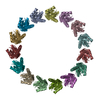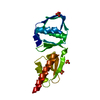[English] 日本語
 Yorodumi
Yorodumi- EMDB-1871: Three-dimensional model of Salmonella's needle complex at subnano... -
+ Open data
Open data
- Basic information
Basic information
| Entry | Database: EMDB / ID: EMD-1871 | |||||||||
|---|---|---|---|---|---|---|---|---|---|---|
| Title | Three-dimensional model of Salmonella's needle complex at subnanometer resolution | |||||||||
 Map data Map data | This in an image of a the surface rendered, extracted volume of the lower neck (15 fold) of the needle complex of the type III secretion system from Salmonella tyhpimurium. | |||||||||
 Sample Sample |
| |||||||||
 Keywords Keywords |  Type III secretion system / Type III secretion system /  Salmonella / outer membrane ring / Salmonella / outer membrane ring /  secretin family / C15 fold secretin family / C15 fold | |||||||||
| Function / homology |  Function and homology information Function and homology information type III protein secretion system complex / type III protein secretion system complex /  type II protein secretion system complex / type II protein secretion system complex /  protein secretion by the type III secretion system / protein secretion by the type III secretion system /  protein secretion / cell outer membrane / identical protein binding protein secretion / cell outer membrane / identical protein bindingSimilarity search - Function | |||||||||
| Biological species |   Salmonella enterica subsp. enterica serovar Typhimurium (bacteria) Salmonella enterica subsp. enterica serovar Typhimurium (bacteria) | |||||||||
| Method |  single particle reconstruction / single particle reconstruction /  cryo EM / Resolution: 8.3 Å cryo EM / Resolution: 8.3 Å | |||||||||
 Authors Authors | Schraidt O / Marlovits TC | |||||||||
 Citation Citation |  Journal: Science / Year: 2011 Journal: Science / Year: 2011Title: Three-dimensional model of Salmonella's needle complex at subnanometer resolution. Authors: Oliver Schraidt / Thomas C Marlovits /  Abstract: Type III secretion systems (T3SSs) are essential virulence factors used by many Gram-negative bacteria to inject proteins that make eukaryotic host cells accessible to invasion. The T3SS core ...Type III secretion systems (T3SSs) are essential virulence factors used by many Gram-negative bacteria to inject proteins that make eukaryotic host cells accessible to invasion. The T3SS core structure, the needle complex (NC), is a ~3.5 megadalton-sized, oligomeric, membrane-embedded complex. Analyzing cryo-electron microscopy images of top views of NCs or NC substructures from Salmonella typhimurium revealed a 24-fold symmetry for the inner rings and a 15-fold symmetry for the outer rings, giving an overall C3 symmetry. Local refinement and averaging showed the organization of the central core and allowed us to reconstruct a subnanometer composite structure of the NC, which together with confident docking of atomic structures reveal insights into its overall organization and structural requirements during assembly. | |||||||||
| History |
|
- Structure visualization
Structure visualization
| Movie |
 Movie viewer Movie viewer |
|---|---|
| Structure viewer | EM map:  SurfView SurfView Molmil Molmil Jmol/JSmol Jmol/JSmol |
| Supplemental images |
- Downloads & links
Downloads & links
-EMDB archive
| Map data |  emd_1871.map.gz emd_1871.map.gz | 17.1 MB |  EMDB map data format EMDB map data format | |
|---|---|---|---|---|
| Header (meta data) |  emd-1871-v30.xml emd-1871-v30.xml emd-1871.xml emd-1871.xml | 8.2 KB 8.2 KB | Display Display |  EMDB header EMDB header |
| Images |  1871.jpg 1871.jpg | 757.6 KB | ||
| Archive directory |  http://ftp.pdbj.org/pub/emdb/structures/EMD-1871 http://ftp.pdbj.org/pub/emdb/structures/EMD-1871 ftp://ftp.pdbj.org/pub/emdb/structures/EMD-1871 ftp://ftp.pdbj.org/pub/emdb/structures/EMD-1871 | HTTPS FTP |
-Related structure data
| Related structure data |  2y9kMC  1874C  1875C  2y9jC C: citing same article ( M: atomic model generated by this map |
|---|---|
| Similar structure data |
- Links
Links
| EMDB pages |  EMDB (EBI/PDBe) / EMDB (EBI/PDBe) /  EMDataResource EMDataResource |
|---|---|
| Related items in Molecule of the Month |
- Map
Map
| File |  Download / File: emd_1871.map.gz / Format: CCP4 / Size: 100.6 MB / Type: IMAGE STORED AS FLOATING POINT NUMBER (4 BYTES) Download / File: emd_1871.map.gz / Format: CCP4 / Size: 100.6 MB / Type: IMAGE STORED AS FLOATING POINT NUMBER (4 BYTES) | ||||||||||||||||||||||||||||||||||||||||||||||||||||||||||||||||||||
|---|---|---|---|---|---|---|---|---|---|---|---|---|---|---|---|---|---|---|---|---|---|---|---|---|---|---|---|---|---|---|---|---|---|---|---|---|---|---|---|---|---|---|---|---|---|---|---|---|---|---|---|---|---|---|---|---|---|---|---|---|---|---|---|---|---|---|---|---|---|
| Annotation | This in an image of a the surface rendered, extracted volume of the lower neck (15 fold) of the needle complex of the type III secretion system from Salmonella tyhpimurium. | ||||||||||||||||||||||||||||||||||||||||||||||||||||||||||||||||||||
| Voxel size | X=Y=Z: 1.33 Å | ||||||||||||||||||||||||||||||||||||||||||||||||||||||||||||||||||||
| Density |
| ||||||||||||||||||||||||||||||||||||||||||||||||||||||||||||||||||||
| Symmetry | Space group: 1 | ||||||||||||||||||||||||||||||||||||||||||||||||||||||||||||||||||||
| Details | EMDB XML:
CCP4 map header:
| ||||||||||||||||||||||||||||||||||||||||||||||||||||||||||||||||||||
-Supplemental data
- Sample components
Sample components
-Entire : Needle complex from Salmonella typhimurium
| Entire | Name: Needle complex from Salmonella typhimurium |
|---|---|
| Components |
|
-Supramolecule #1000: Needle complex from Salmonella typhimurium
| Supramolecule | Name: Needle complex from Salmonella typhimurium / type: sample / ID: 1000 / Number unique components: 1 |
|---|
-Macromolecule #1: Protein invG
| Macromolecule | Name: Protein invG / type: protein_or_peptide / ID: 1 / Name.synonym: invG / Recombinant expression: No |
|---|---|
| Source (natural) | Organism:   Salmonella enterica subsp. enterica serovar Typhimurium (bacteria) Salmonella enterica subsp. enterica serovar Typhimurium (bacteria) |
-Experimental details
-Structure determination
| Method |  cryo EM cryo EM |
|---|---|
 Processing Processing |  single particle reconstruction single particle reconstruction |
| Aggregation state | particle |
- Sample preparation
Sample preparation
| Buffer | pH: 7.5 / Details: 10mM Tris-HCl 0.5M NaCl 0.1% LDAO |
|---|---|
| Vitrification | Cryogen name: ETHANE / Instrument: OTHER |
- Electron microscopy
Electron microscopy
| Microscope | FEI POLARA 300 |
|---|---|
| Electron beam | Acceleration voltage: 300 kV / Electron source:  FIELD EMISSION GUN FIELD EMISSION GUN |
| Electron optics | Illumination mode: FLOOD BEAM / Imaging mode: BRIGHT FIELD Bright-field microscopy / Nominal magnification: 93000 Bright-field microscopy / Nominal magnification: 93000 |
| Sample stage | Specimen holder: Eucentric / Specimen holder model: GATAN LIQUID NITROGEN |
| Image recording | Digitization - Sampling interval: 15 µm / Bits/pixel: 8 |
| Experimental equipment |  Model: Tecnai Polara / Image courtesy: FEI Company |
- Image processing
Image processing
| CTF correction | Details: Micrograph |
|---|---|
| Final reconstruction | Applied symmetry - Point group: C15 (15 fold cyclic ) / Algorithm: OTHER / Resolution.type: BY AUTHOR / Resolution: 8.3 Å / Resolution method: FSC 0.5 CUT-OFF / Software - Name: IMAGIC ) / Algorithm: OTHER / Resolution.type: BY AUTHOR / Resolution: 8.3 Å / Resolution method: FSC 0.5 CUT-OFF / Software - Name: IMAGIC |
-Atomic model buiding 1
| Initial model | PDB ID: Chain - Chain ID: A |
|---|---|
| Details | Protocol: Rigid body. Based on the homolog EscC (PDB entry above) a model was built for InvG (Swissprot - template based modeling), which was subsequently used for the fitting experiment (rigid body, Software CHIMERA) |
| Refinement | Space: REAL / Protocol: RIGID BODY FIT |
| Output model |  PDB-2y9k: |
 Movie
Movie Controller
Controller










